The Nigella flower, also known as Love-in-a-Mist, holds deep spiritual significance across many cultures. It is believed to symbolize protection, healing, peace, and transformation, making it a powerful emblem in both art and tradition. This unique flower is known for its delicate, misty appearance and rich history, which adds layers of meaning to its spiritual symbolism.
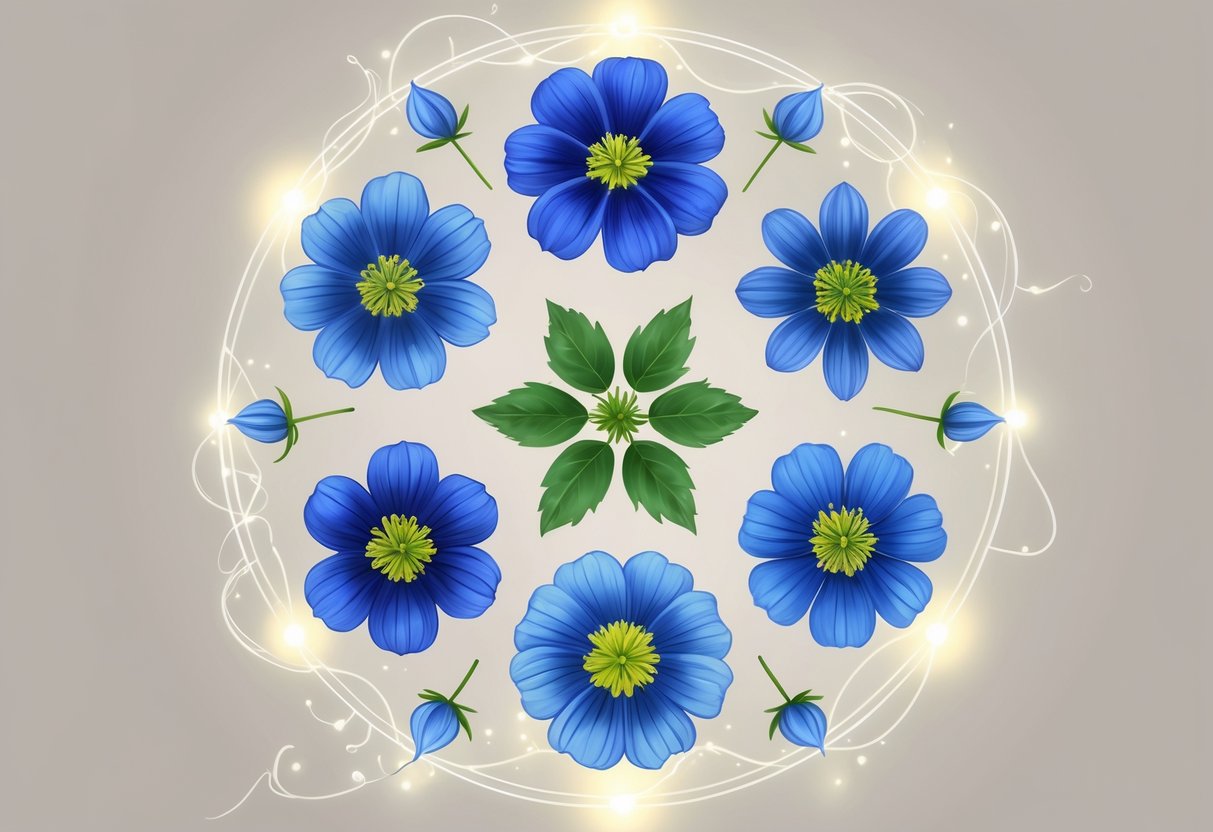
People have long associated the Nigella flower with qualities like love, hope, and renewal. Its seeds are used in traditional medicine, believed to have healing properties, while culturally, the flower often represents harmony and the cycle of life. Exploring these spiritual meanings helps one understand why the Nigella flower continues to inspire and hold importance today.
Key Takeways
- The Nigella flower symbolizes protection and spiritual growth.
- It connects to themes of healing and renewal in various cultures.
- Its unique look enhances its meaning in art and spiritual beliefs.
What Is the Nigella Flower?
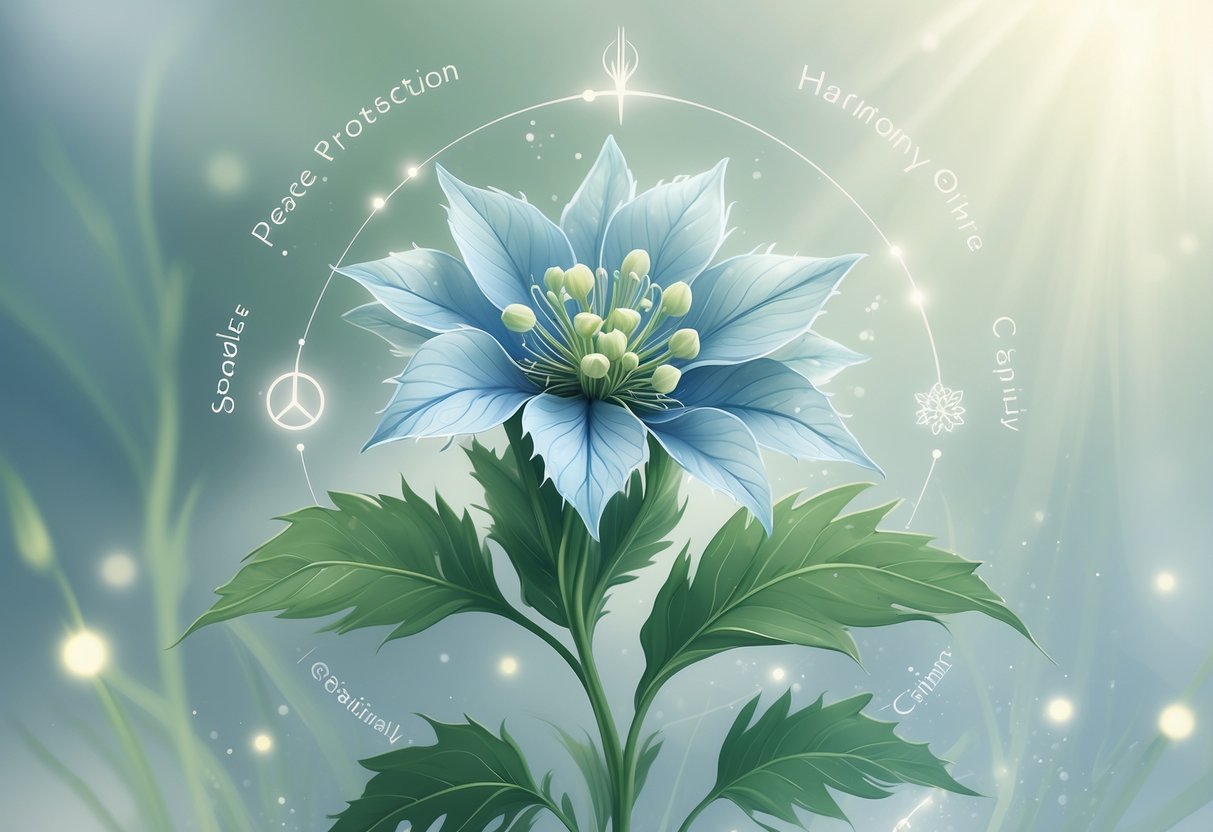
The Nigella flower is known for its delicate beauty and unique features. It belongs to a specific plant family and includes several varieties with distinct traits. Its common names and appearance make it popular in gardens, while its cultivation needs reflect where and how it naturally grows.
Scientific Classification and Varieties
Nigella belongs to the Ranunculaceae family, a group known for many ornamental plants. The most well-known species is Nigella damascena, often called Love-in-a-Mist. This species is an annual plant that produces striking blue flowers surrounded by feathery foliage.
Another important species is Nigella sativa, known as black cumin. Unlike Nigella damascena, this variety is grown mainly for its seeds, which are used as a spice and for medicinal purposes. While Nigella damascena is mostly ornamental, Nigella sativa has agricultural and culinary value, especially in Middle Eastern and Indian cuisines.
Common Names and Appearance
The Nigella flower goes by several names. The most popular is Love-in-a-Mist, named for the fine, mist-like layer of fern-like leaves surrounding the flower. Its petals often come in pale blue, white, or sometimes pink.
This flower’s appearance includes a central seed pod surrounded by multiple slender petals and delicate bracts. The foliage resembles fennel, giving the plant a lacy look that enhances its charm in gardens.
Nigella sativa, or black cumin, differs in appearance. It has smaller, less showy flowers and is primarily cultivated for its dark seeds, which are used as a spice known for their slightly bitter, nutty flavor.
Cultivation and Habitat
Love-in-a-Mist (Nigella damascena) thrives in temperate climates. It prefers well-drained soil and full sun to partial shade. This plant grows best in gardens or meadows where conditions allow for good air circulation and moderate watering.
Nigella damascena is native to Southern Europe, Southwest Asia, and North Africa. It has since been naturalized in parts of Northern Europe due to its adaptability.
Nigella sativa, the black cumin plant, grows in warmer regions and is cultivated mainly in the Middle East, India, and parts of Africa. It requires dry conditions and well-drained soil, often thriving where many other plants might struggle. Its seeds are harvested after flowering and drying.
Both types of Nigella are relatively easy to grow but have distinct habitat needs depending on their species and purpose.
Core Spiritual Meanings of Nigella Flower
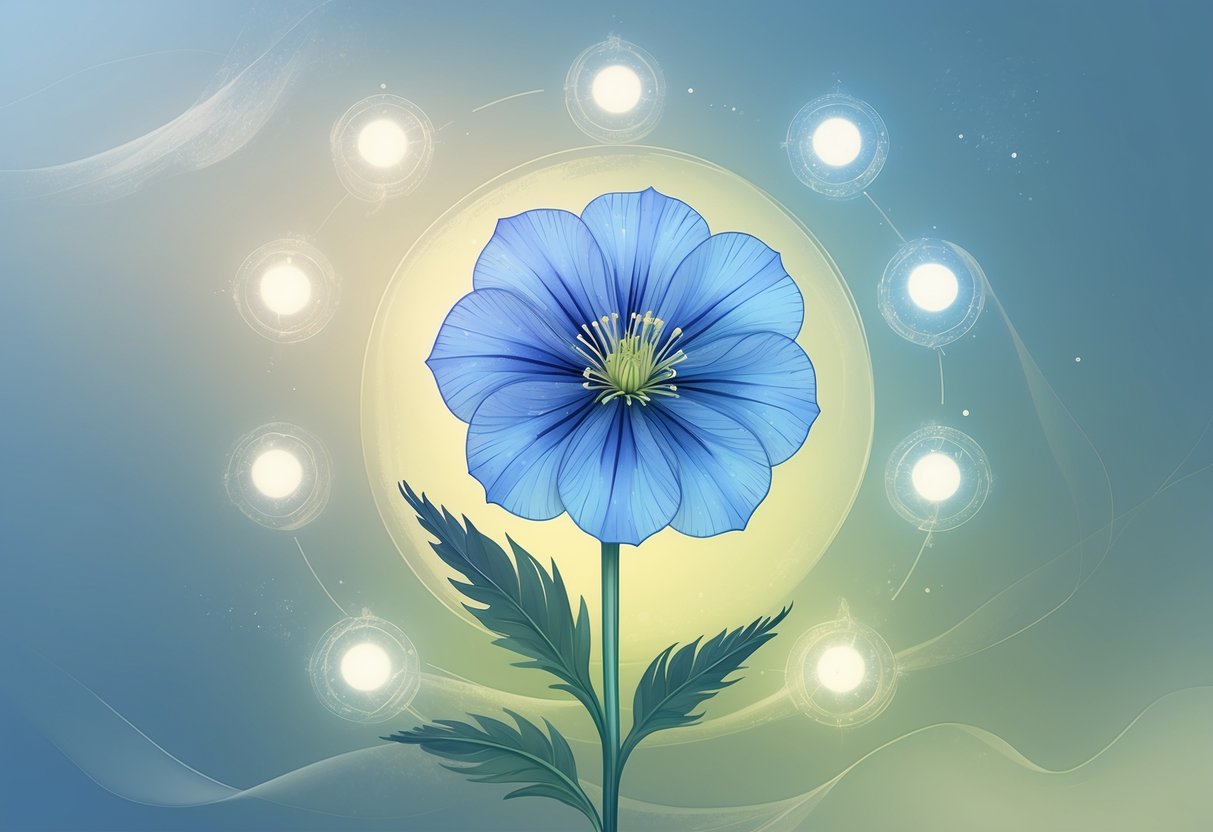
The Nigella flower carries powerful symbolic meanings connected to protection, love, purity, and personal growth. Its spiritual significance is reflected in how different cultures interpret its energy and presence. The flower represents both emotional and physical well-being, guiding people through challenges and transitions.
Protection Against Negative Energies
Nigella flowers are believed to have the power to guard against harmful influences. In many traditions, carrying or displaying the flower is thought to create a barrier against evil spirits and negative vibes. This protective quality has roots in ancient ceremonies where Nigella was part of rituals aiming to keep bad fortune away.
The flower’s association with protection often extends to physical health. Its seeds have been used in traditional medicine to support healing and reduce inflammation. This dual role of spiritual and bodily protection highlights Nigella’s unique place in both folklore and practical use.
Symbol of Love and Romantic Bonds
Nigella, often called “Love-in-a-Mist,” symbolizes complex emotions in romantic relationships. It represents the confusion and wonder that can come with love, especially in new or uncertain phases. This adds depth to its meaning, showing that love is not only pure joy but also an experience with challenges.
Throughout history, Nigella flowers have been used in wedding decorations and love charms. Their delicate petals and misty foliage express grace and tender feelings. The flower stands for both longing and hope in matters of the heart, making it a popular emblem in art and culture related to romance.
Purity and Innocence
The Nigella flower also represents purity and innocence. Its clean, delicate petals symbolize a fresh start and a state of untouched beauty. This meaning connects to spiritual ideas of cleansing and renewal, where the flower serves as a reminder to maintain inner clarity.
In some cultures, Nigella is used to honor peaceful intentions and a pure heart. It appears in garlands and offerings aimed at promoting harmony and forgiveness. This aspect of Nigella highlights its role in encouraging gentle strength and kindness in human relationships.
Hope and Transformation
Nigella flowers are tied to themes of hope and change. Seeing or receiving the flower can symbolize a new beginning or the need to embrace growth. It represents the natural process of transformation, both in life and spirit.
Mythologies link Nigella to cycles of death and rebirth, suggesting its power to bring recovery and renewal. Spiritually, it encourages openness to new opportunities and resilience during difficult times. This symbolism makes Nigella a meaningful guide for anyone undergoing important life shifts.
Nigella Flower in Cultural Beliefs and Folklore
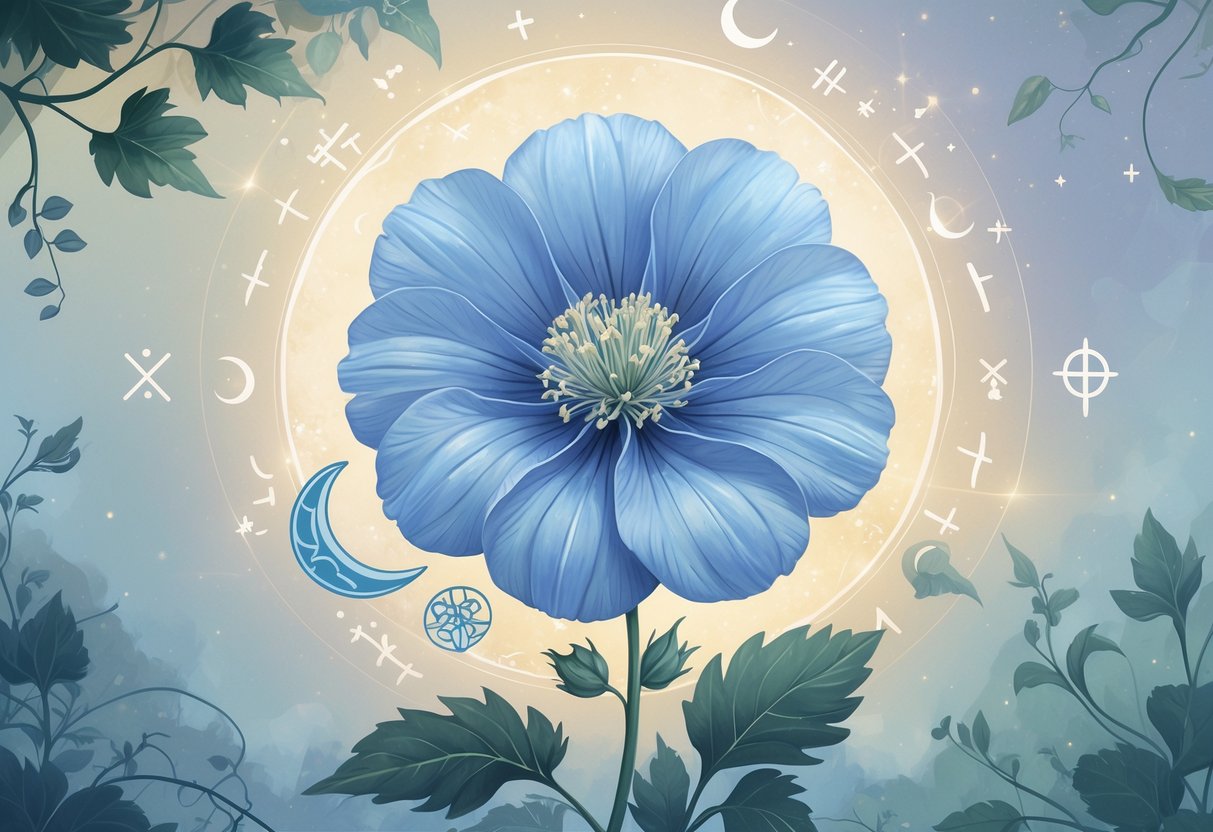
The Nigella flower holds a unique place in many cultures, often connected to protection, healing, and symbolic meanings. Its history links to rituals, myths, and religious traditions that highlight its spiritual and practical value.
Ancient Ceremonial Uses
In ancient times, Nigella flowers were used in various ceremonies to ward off evil spirits and bring protection. Many cultures believed carrying or displaying these flowers could keep negative energy away. They often featured in garlands and wreaths for special events, symbolizing purity and peace.
Medicinally, the seeds were valued for healing properties. People used them to treat ailments like headaches or digestive problems, combining practical healing with spiritual protection.
Gardens and monastery grounds sometimes grew Nigella as a symbol of divine grace, reflecting its role beyond simple decoration into the spiritual realm.
Legends and Mythology
Nigella flowers appear in several myths, especially in Greek and Hindu traditions. One Greek myth says the flower grew from the tears of the goddess Demeter when she mourned her lost daughter, Persephone. This story links the flower to mourning, hope, and rebirth.
In Hindu mythology, Nigella is connected to Lord Shiva, believed to protect his wife Parvati from evil spirits by creating the flower. This highlights its role as a guardian in spiritual stories.
Across cultures, Nigella is seen as a symbol of transformation and renewal, often tied to life’s cycles and protection against harm.
Nigella in Religious Texts
Nigella seeds, sometimes called “blessed seed,” are mentioned in Islamic tradition as having strong healing qualities. The Prophet Muhammad reportedly described them as a cure for many illnesses, except death. This belief made Nigella important in traditional medicine and spiritual practice.
In Christianity, Nigella’s presence in religious art and manuscripts often symbolized divine grace and purity. The flower was used in gardens near monasteries to inspire peace and contemplation.
These religious connections show how Nigella serves as both a symbol and a tool for spiritual growth and physical healing across faiths.
8 Spiritual Symbolisms of Nigella Flower
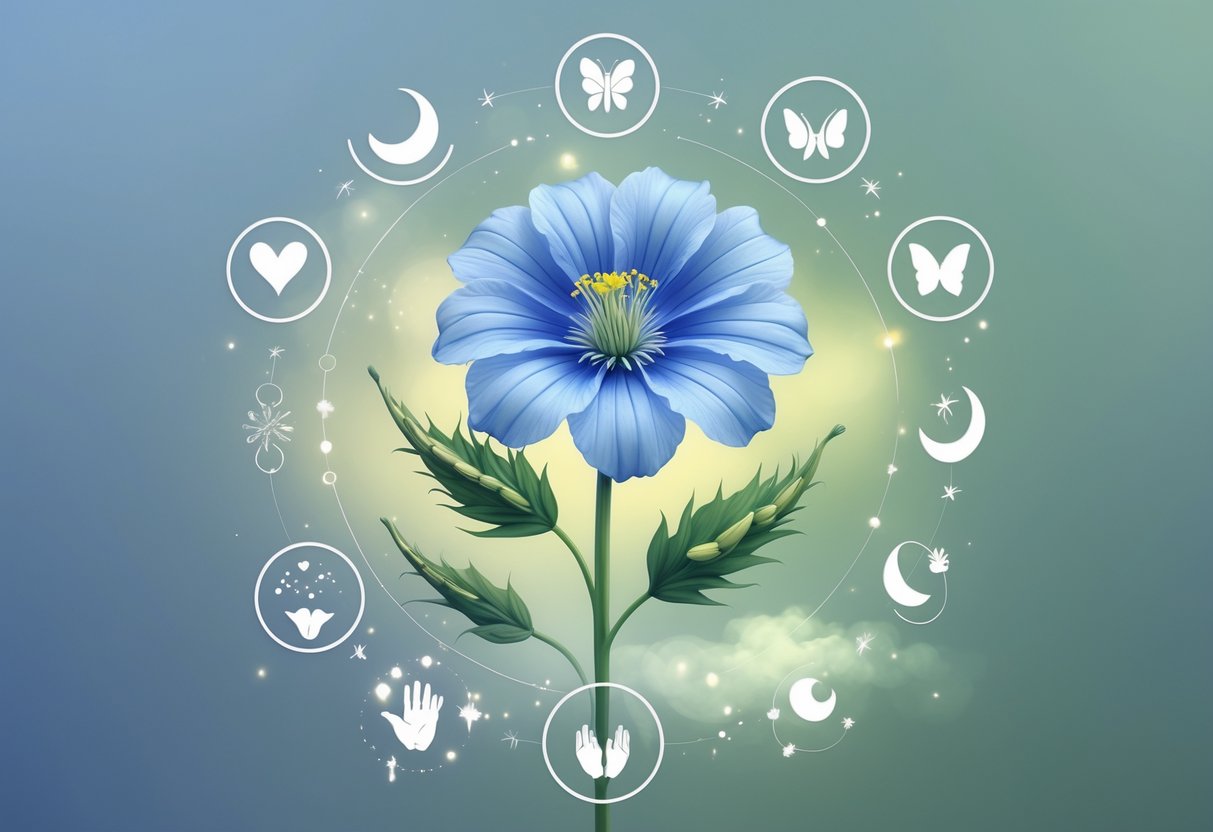
The Nigella flower carries meanings connected to protection, growth, and healing. It reflects qualities like promising fortune, new beginnings, inner strength, and restorative energy. These aspects have roots in different cultures and traditions.
Luck and Fortune
Nigella is often seen as a symbol of good luck. People believe it helps protect against negative energies and evil spirits. In many cultures, carrying or planting these flowers is thought to bring positive energy and success.
Its seeds, called “blessed seeds” in Islamic tradition, are linked to fortune and healing. This idea of luck ties closely with spiritual protection, making Nigella a favored flower to attract goodwill and blessings. It serves as a reminder to stay hopeful and open to opportunities.
Fertility and New Life
The flower represents fertility and the start of new life cycles. Historically, Nigella was used in ceremonies expecting blessings for fertility, purity, and peace. Its delicate blue petals surrounded by fine leaves create an image of birth rising from mist or confusion.
This symbolism extends to growth beyond just physical fertility. It also points to personal renewal and transformation. The flower encourages embracing change and new phases in life with openness and grace.
Strength and Courage
Nigella embodies inner strength and courage in the face of uncertainty. Its nickname, “Love-in-a-Mist,” reflects the confusion often found in romantic or challenging situations, yet the flower endures and blooms beautifully despite this.
The delicate yet resilient nature of Nigella serves as a metaphor to face difficulties with calm and fortitude. It inspires confidence and bravery through trials, reminding people to remain steadfast in their goals and emotions.
Healing Energy
The Nigella flower and its seeds carry a long history of medicinal use. They are believed to have healing powers for physical issues like headaches, digestion, and respiratory conditions.
Spiritually, the flower symbolizes holistic health—both body and soul. It encourages care for physical well-being while promoting spiritual balance. The flower’s healing energy stands as a symbol to nurture oneself and seek restoration in times of stress or illness.
Nigella Flower Colors and Their Spiritual Associations
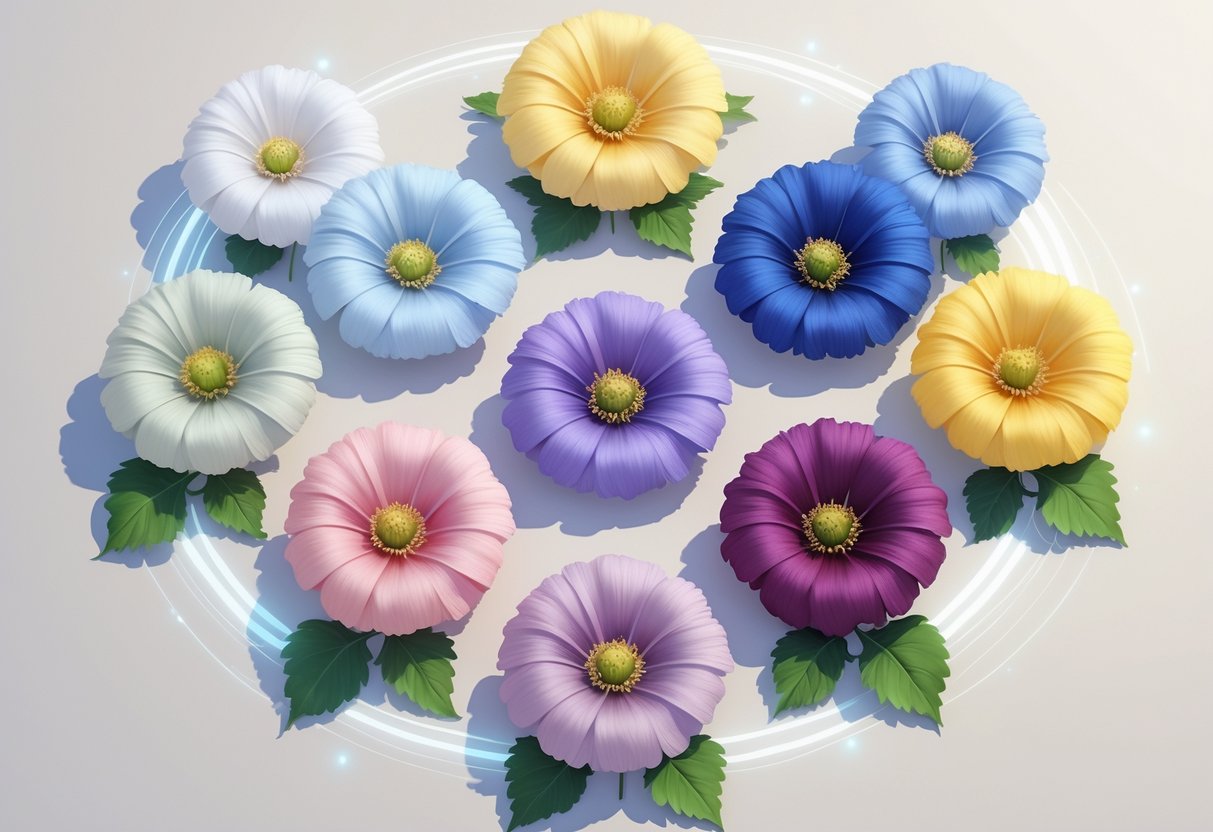
The colors of Nigella flowers each carry specific spiritual meanings that connect to emotions and personal qualities. These colors influence how the flower is seen in ceremonies, art, and healing practices. The shades highlight qualities like calmness, purity, and spiritual depth.
Blue: Peace and Inspiration
Blue Nigella flowers are often linked to peace and calmness. Their soft, sky-like color creates a sense of serenity and helps inspire clear thinking. This blue tone encourages reflection and spiritual insight, making it popular in meditative or healing spaces.
Blue also symbolizes loyalty and trust. People may use blue Nigella in rituals or gifts to express faithfulness or to support someone seeking emotional stability. The color’s quiet strength adds to the flower’s natural grace and elegance, drawing those who value emotional balance.
White: Divine Love and Purity
White Nigella flowers represent purity and innocence. Their clean, bright color often symbolizes new beginnings and spiritual clarity. In many traditions, white is connected to divine love, making the flower a symbol of sacred and unconditional emotion.
This white hue invites a feeling of purity in both heart and mind. It fits well in spiritual ceremonies or events that focus on renewal and peace. White Nigella’s simple elegance highlights the flower’s role in representing peace and sacred connection.
Pink and Purple: Grace and Duality
Pink and purple Nigella flowers carry a dual meaning. Pink reflects love, tenderness, and gentle grace, while purple conveys spirituality, mystery, and deeper emotional layers. Together, these colors symbolize the balance between earthly emotions and spiritual growth.
Pink adds softness and warmth to the flower’s image, often linked to romance and kindness. Purple deepens this connection with its association to wisdom and transformation. These colors embody both the delicate and complex sides of life, enhancing Nigella’s elegant appearance.
Nigella Flower in Traditional Medicine and Healing
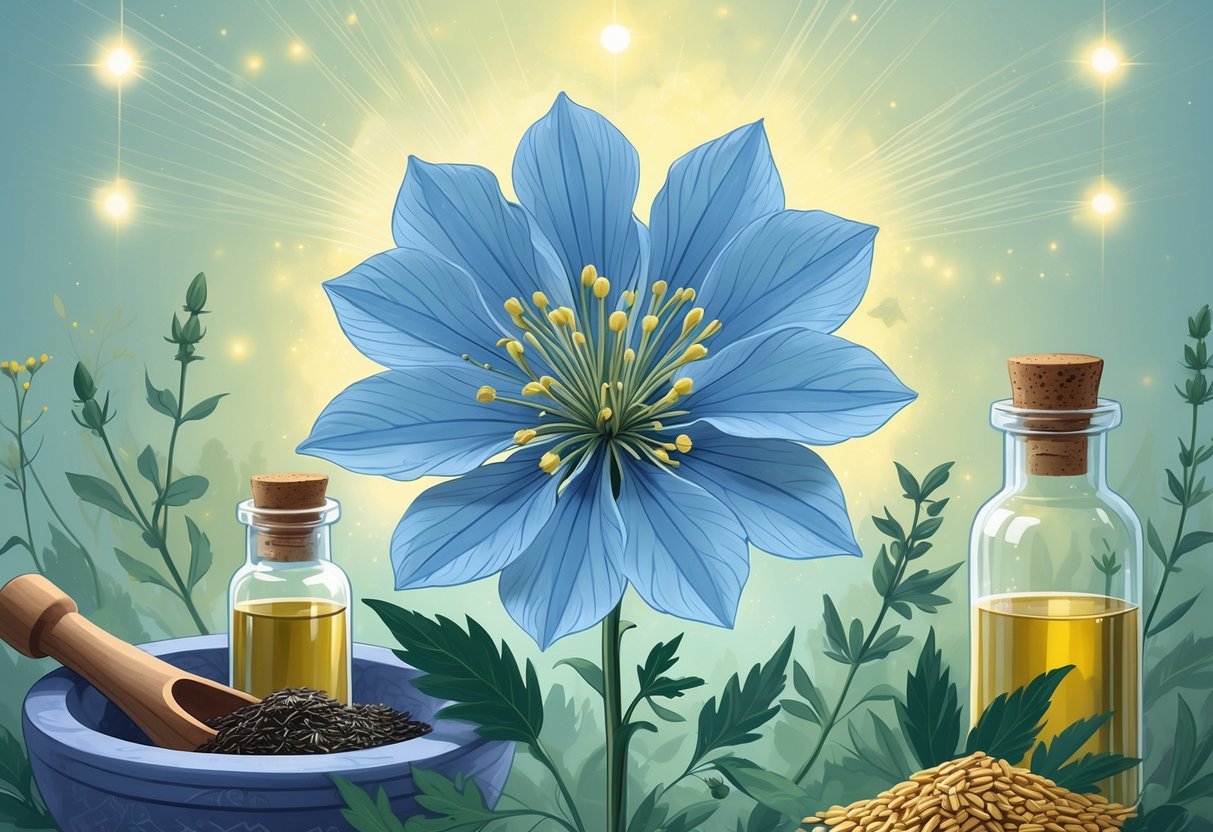
Nigella, especially Nigella sativa, has been valued for its healing properties across many cultures. Its seeds contain compounds used to address various physical ailments. This plant plays an important role in traditional medicine and natural healing.
Medicinal Properties of Nigella Seeds
Nigella sativa seeds are known for their anti-inflammatory and antioxidant effects. They have been used to relieve headaches, digestive problems, and respiratory issues. The seeds contain bioactive compounds like thymoquinone, which contribute to these healing benefits.
The oil extracted from the seeds is applied to skin conditions and used to support respiratory health. It has been traditionally taken to help reduce pain and improve overall well-being. Studies confirm the seeds’ potential to fight bacteria and fungi, adding to their medicinal value.
Use in Holistic Practices
In holistic medicine, Nigella is often used as a natural remedy within therapies like Ayurveda and herbal healing. The seeds are sometimes referred to as a “cure-all” due to their broad use in treating common ailments and strengthening the immune system.
Practitioners may recommend Nigella supplements or oils to support digestion, boost energy, and reduce inflammation. Its consistent use in folk medicine across the Middle East, Asia, and Africa highlights its importance in holistic healing traditions.
Follow us on Social Media!
